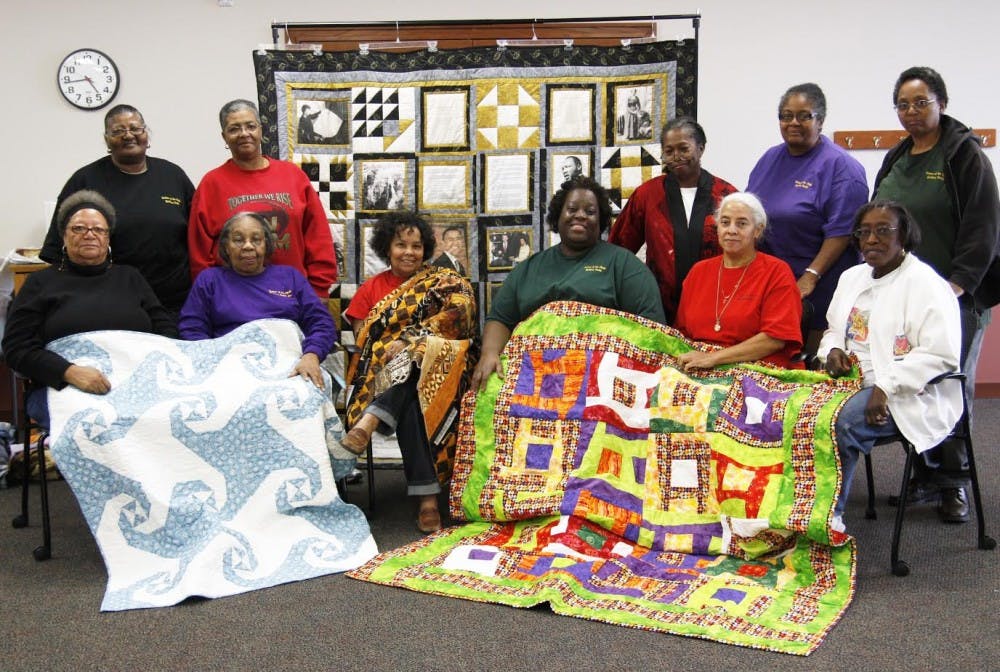The Mathers Museum of World Cultures has invited a variety of Indiana artisans to demonstrate their crafts as part of their series “The Beauty of Indiana Folk Arts,” planned in conjunction with Themester 2016, which focuses on beauty.
The latest in this demonstration and talk series will be three separate presentations by Sisters of the Cloth, an African American quilting guild based in Fort Wayne, Indiana. The demonstrations will take place at 10:30 a.m. and 2:30 p.m. today, with a special presentation of “bedturning” at 11:45 a.m.
Jon Kay, curator of these demonstrations and a professor of practice in the Department of Folklore and Ethnomusicology, said he has worked with this group several times in the past and they represent both creativity and community awareness.
“They do a lot of social work together, quilts for premature babies, veterans,” Kay said. “They’re very socially conscious, and their work is beautiful. They use a lot of traditional patterns but also a lot of individual creativity with the work they do, often incorporating African textile patterns. They are a distinctive and vibrant group of local quilters.”
One of the demonstrations the quilters will share is the bedturning.
During this portion of the day, a mattress will be covered in around 20 quilts, each one with its own quilter and story attached, Kay said.
As each quilt is lifted from the mattress, a narrator will read the profile of that quilt. The profile is provided by the quilter who made the quilt and will give insight into the inspiration and what they appreciate most about that individual piece.
“It’s kind of their opportunity to show off the best of their work and draw the audiences’ eyes to the subtle aesthetic forms of the quilt,” Kay said. “In a short amount of time, you’ll get to hear about all different types of quilts made by this group.”
Maxine Stovall, a member of the group since 2002, said Sisters of the Cloth provided her with a network of local artisans and close friends.
“The most favorite part for me is the companionship, the camaraderie with the other ladies, the support and the fun that we have when we get together,” Stovall said. “A lot of times we’ll get together with the intent to sew and never get the machines on.”
Stovall said her mother did sew but mostly for the practical reason of creating quilts to keep warm. As a child, she said she did not understand or take up the practice of sewing.
Stovall first became interested in sewing and in the collective when she was purchasing a home.
She visited her realtor, also a member, and saw the quilts and fabrics around her home.
Today, Stovall is one of the sole quilters in her family, and her list of family members to sew for is long.
“That’s been most fun for me — making them, giving them away and letting people enjoy them,” Stovall said.
Stovall said she gives quilts to family members and also donates them to charities or charitable events. Most recently, she visited a niece who was diagnosed with breast cancer five years ago.
“She said it is the softest and most comfortable quilt she has,” Stovall said. “She puts over herself as she goes through treatment. I’m glad that it’s not just a utility for her. It’s a comfort for her.”
The quilters have various reasons for joining, and they unite under their motto, “Each one teach one,” Stovall said. One major goal is to pass along the skill to those interested in maintaining and supporting the art form, she said.
“We are now teaching children how to hand sew,” Stovall said. “Anyone who wants to learn how to quilt to keep that art alive, we’ll teach. Right now, we’re working with a group of children from a community center in Fort Wayne. That’s been a good part of this group, too.”
Kay said the connective quality of quilting is one of the most fundamental elements in groups like Sisters of the Cloth and others. In his classes, Kay said he calls attention to this quality when discussing art forms like quilting. Along with a physical product, these quilters create and connect to those around them.
“What we’re focusing on is the social aspect of whatever the creative practice is — how the art that somebody makes connects them to other people,” Kay said. “The beauty of Indiana folk art through these quilts is, through creative practice, it creates bonds with these quilters, their family and their community.”






